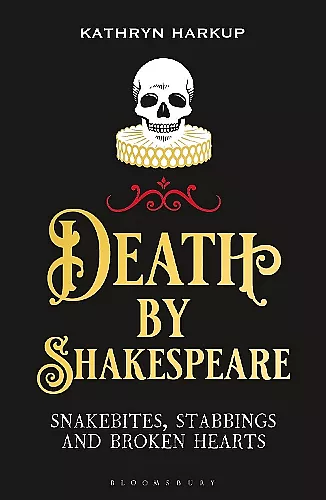Death By Shakespeare
Snakebites, Stabbings and Broken Hearts
Format:Paperback
Publisher:Bloomsbury Publishing PLC
Published:3rd Feb '22
Should be back in stock very soon

An in-depth look at the science behind the creative methods Shakespeare used to kill off his characters
A deep dive into the science behind the creative ways Shakespeare killed off his characters.
William Shakespeare found dozens of different ways to kill off his characters, and audiences today still enjoy the same reactions – shock, sadness, fear – that they did more than 400 years ago when these plays were first performed. But how realistic are these deaths, and did Shakespeare have the knowledge to back them up?
In the Bard’s day death was a part of everyday life. Plague, pestilence and public executions were a common occurrence, and the chances of seeing a dead or dying body on the way home from the theatre were high. It was also a time of important scientific progress. Shakespeare kept pace with anatomical and medical advances, and he included the latest scientific discoveries in his work, from blood circulation to treatments for syphilis. He certainly didn’t shy away from portraying the reality of death on stage, from the brutal to the mundane, and the spectacular to the silly.
Elizabethan London provides the backdrop for Death by Shakespeare, as Kathryn Harkup turns her discerning scientific eye to the Bard and the varied and creative ways his characters die. Was death by snakebite as serene as Shakespeare makes out? Could lack of sleep have killed Lady Macbeth? Can you really murder someone by pouring poison in their ear? Kathryn investigates what actual events may have inspired Shakespeare, what the accepted scientific knowledge of the time was, and how Elizabethan audiences would have responded to these death scenes. Death by Shakespeare will tell you all this and more in a rollercoaster of Elizabethan carnage, poison, swordplay and bloodshed, with an occasional death by bear-mauling for good measure.
Harkup’s enjoyable and informative survey presents this somatic Shakespeare for the Horrible Histories generation. * Times Literary Supplement *
Were I a school-teacher introducing phone-addicted teens to Macbeth or Romeo and Juliet, I'd go in big on Shakespeare's 'violent delights'. * Daily Mail (4 stars) *
Well-written and intriguing, the book provides a rich behind-the-scenes look at science and historical fact, using the focus on death to deepen understanding of Shakespeare’s life and work. * Historical Novel Society *
The author of A Is for Arsenic and Making the Monster: The Science Behind Mary Shelley’s Frankenstein continues her macabre cultural musings with an immensely readable roundup of Shakespearean death. * Smithsonian Magazine *
Death By Shakespeare is a macabre but fascinating read, rich in historical context, scientific insight, and intriguing asides. * Ellery Queen's Mystery Magazine *
Harkup serves a delectable stew of history, science and wit that is sure to sate the appetite of any Anglophile. * Booklist *
Serious scholarship meets horrid histories. Kathryn Harkup located Death by Shakespeare within the contexts of science and medicine, health and safety, crime and punishment, and in the process gives us tour de force descriptions of Juliet's deep coma, Cleopatra's asp, Ophelia's drowning and the carnage at Agincourt, among other celebrated exits. It's a good read – never morbid, and full of insights into the Tudor way of death and how far we've come. -- Professor Sir Christopher Frayling, cultural historian, writer and broadcaster
Light enough to be a quick read for fun but hefty enough to educate, this is a book that any student would be happy to study for a class, and it’s a solid addition to any nonfiction or Shakespearean fan’s collection. Yet again, Harkup has delivered a satisfying, sterling examination of an iconic figure’s literary contributions to history. * Criminal Element *
ISBN: 9781472958204
Dimensions: unknown
Weight: 254g
368 pages